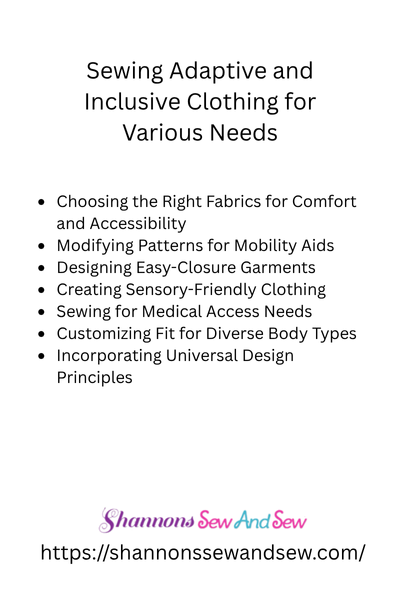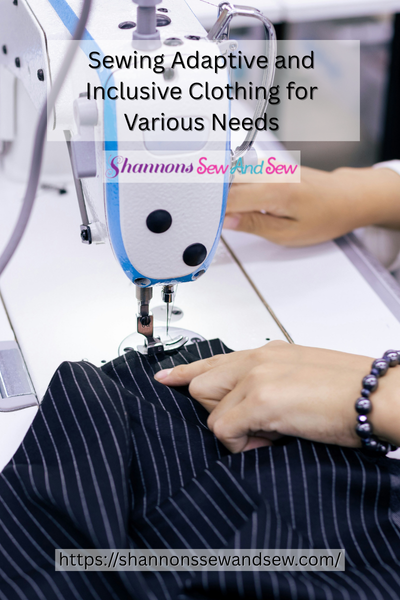Sewing Clothes
Sewing Adaptive and Inclusive Clothing for Various Needs
Sewing adaptive and inclusive clothing for various needs isn’t just a trend—it’s a game changer. Whether you’re tackling a custom project for a loved one, starting a side hustle, or simply curious about how fashion can be more functional, you’re in the right place.
Read More About Sewing Adaptive and Inclusive Clothing for Various Needs

Why Adaptive Clothing Matters
Let’s be honest—most mainstream clothing isn’t made with everyone in mind. Buttons, zippers, tight sleeves, or even standard hemlines can be real challenges for people with disabilities, sensory sensitivities, or limited mobility. That’s where sewing adaptive and inclusive clothing for various needs steps in like a superhero with a sewing machine.
I’ll never forget the time my uncle had shoulder surgery. He couldn’t lift his arm high enough to wear a regular tee. We tried cutting up an old one and adding snaps along the side—it looked like a Frankenstein shirt, but wow, was it helpful. That was my lightbulb moment. I realized sewing adaptive clothes doesn’t have to be clinical or boring. It can be stylish and functional.
More Things to Know About Sewing Adaptive and Inclusive Clothing for Various Needs

Who Needs Adaptive and Inclusive Clothing?
Honestly, a whole lot of people. Folks using wheelchairs, kids with autism, adults recovering from surgery, people with arthritis—you name it. When you start sewing adaptive and inclusive clothing for various needs, you start to see fashion in a totally different way.
It’s not just about how a piece looks on a hanger. It’s about how easily someone can get into it, how it feels on their skin, and whether it actually works for their daily life.
What Makes Clothing Adaptive?
Think Velcro closures instead of buttons, magnetic snaps, extra room in the back for sitting comfort, soft fabrics that won’t irritate sensitive skin, or pants that open along the sides for easier dressing. The list goes on—and it should.
One of the coolest projects I did was a pair of jeans with a zipper that ran from ankle to thigh. A friend needed them after leg surgery. They looked like normal jeans but made dressing so much easier. And honestly, I felt like a total rockstar handing them over.
Tips for Getting Started
If you’re new to sewing adaptive and inclusive clothing for various needs, don’t panic. You don’t have to reinvent the sewing wheel. Start small—modify existing patterns or upcycle old clothes. Look at where the frustrations are: Is it the fasteners? The way the sleeves pull? The waistband?
Also—ask questions. If you’re sewing for someone specific, they’ll know what they need better than anyone. And don’t be afraid to try things out. What doesn’t work is just a lesson for next time.
It’s Not All Medical
Here’s something that surprised me: adaptive clothing doesn’t have to scream “medical.” You can add stylish elements—fun fabrics, contrasting trims, cool textures. That’s one of the best parts about sewing adaptive and inclusive clothing for various needs: you get to mix creativity with real problem-solving.
I once made a hoodie with hidden magnetic closures and a wide opening for someone with cerebral palsy. It looked like something you’d buy off the rack at a boutique, and the person wearing it felt good—really good. That’s what it’s all about, right?
Common Challenges (And How to Beat Them)
You’ll run into snags—literally and figuratively. Sourcing adaptive hardware like magnetic snaps or specialty zippers might take some Googling. And pattern adjustments can feel like a guessing game at first. But stick with it. The learning curve is worth it.
Sometimes I mess up measurements or forget to reinforce a seam, but every misstep has taught me something. Like: always triple-check where a snap lands before you sew it down. Trust me.
The Reward is Real
There’s a deep sense of satisfaction that comes with sewing adaptive and inclusive clothing for various needs. It’s creative, it’s helpful, and you’re literally making life easier for someone else. That’s powerful stuff.
Plus, once you get the hang of it, you might find yourself sewing for your local community, offering custom work, or even launching a niche clothing line. The possibilities are huge—and honestly, kind of exciting.
Sleepwear Sewing Is the Ultimate Comfort Craft
So, yeah—sewing adaptive and inclusive clothing for various needs might seem intimidating at first. But it’s also one of the most rewarding, meaningful paths you can take as a sewist. Whether you’re stitching for family, friends, or strangers, you’re creating comfort, confidence, and independence—one seam at a time.
Have you tried sewing something adaptive before? I’d love to hear your story. And if you’re just getting started, don’t worry. You’ve totally got this—and I’m cheering you on every stitch of the way.




















